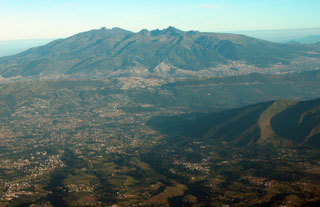Report on Guagua Pichincha (Ecuador) — December 2007
Bulletin of the Global Volcanism Network, vol. 32, no. 12 (December 2007)
Managing Editor: Richard Wunderman.
Guagua Pichincha (Ecuador) Seven moderate phreatic eruptions on 1 February 2008
Please cite this report as:
Global Volcanism Program, 2007. Report on Guagua Pichincha (Ecuador) (Wunderman, R., ed.). Bulletin of the Global Volcanism Network, 32:12. Smithsonian Institution. https://doi.org/10.5479/si.GVP.BGVN200712-352020
Guagua Pichincha
Ecuador
0.171°S, 78.598°W; summit elev. 4784 m
All times are local (unless otherwise noted)
Following December 2007 seismicity, Guagua Pichincha generated phreatic eruptions multiple times on 1 February 2008. The summit lies only ~ 8 km W of the limits of Ecuador's capital, Quito. Our last report summarized events through January 2004 (BGVN 29:06).
In lead-up to the phreatic eruptions, the Instituto Geofísico Escuela Politécnica Nacional (IG-EPN), reported that an M 4.1 earthquake occurred in the vicinity on 6 December 2007, followed a week later by an increase in fracture earthquakes. These events, continuing through 23 December, were below M 3 and occurred at shallow depths within the volcano. On 24-30 December 2007, IG-EPN indicated that the fumaroles were stable.
IG-EPN reported that a slight increase in activity had been observed over a few weeks at the end of January 2008. This activity culminated on 1 February with seven phreatic explosions of moderate size. IG-EPN went on to say that these phreatic eruptions generally occur during rainy periods, so these explosions are not necessarily indicative of any increase in activity. Since this type of event may occur again, however, IG-EPN recommended that visitors not descend into the caldera. This was mentioned in a 2 February news report in El Pais, which further mentioned that strong rains that had recently fallen in Quito and the crater.
As of 14 February, Ash Advisories cataloged by the Washington VAAC's lacked reports describing the 1 February, or any subsequent, phreatic eruptions.
Geological Summary. Guagua Pichincha and the older Pleistocene Rucu Pichincha stratovolcanoes form a broad volcanic massif that rises immediately W of Ecuador's capital city, Quito. A lava dome grew at the head of a 6-km-wide scarp formed during a late-Pleistocene slope failure ~50,000 years ago. Subsequent late-Pleistocene and Holocene eruptions from the central vent consisted of explosive activity with pyroclastic flows accompanied by periodic growth and destruction of the lava dome. Many minor eruptions have been recorded since the mid-1500's; the largest took place in 1660, when ash fell over a 1,000 km radius and accumulated to 30 cm depth in Quito. Pyroclastic flows and surges also occurred, primarily to then W, and affected agricultural activity.
Information Contacts: Instituto Geofísico Escuela Politécnica Nacional (IG-EPN), Apartado 17-01-2759, Quito, Ecuador (URL: http://www.igepn.edu.ec/).

